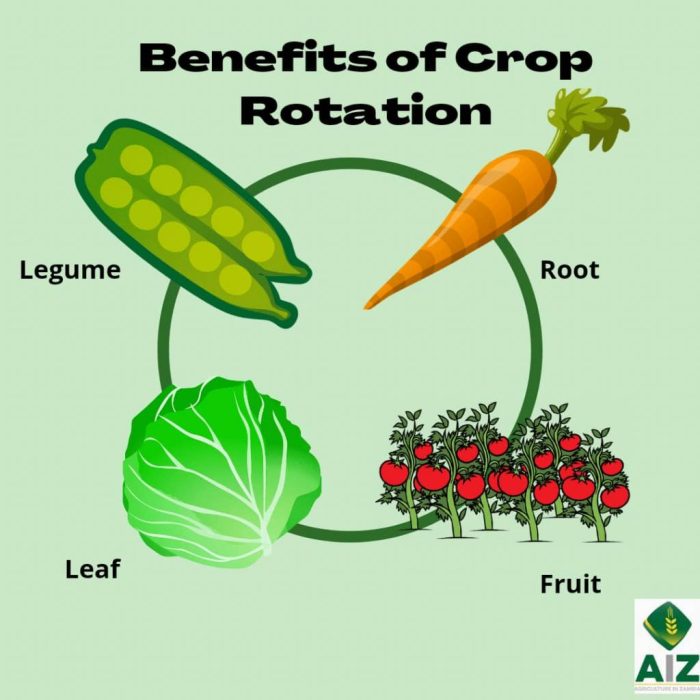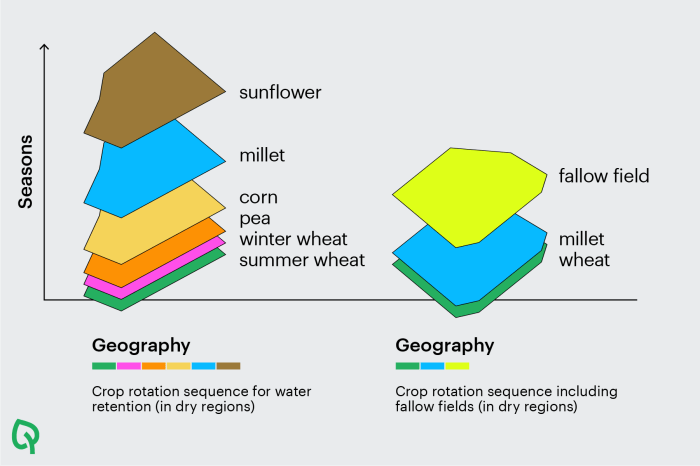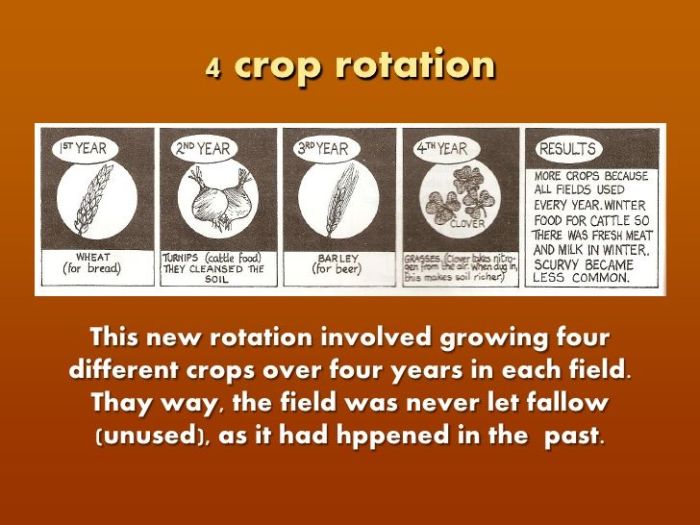Crop rotation ap human geography delves into the multifaceted practice of crop rotation, exploring its environmental, economic, and agricultural implications. By alternating different crops in a specific sequence, farmers can optimize soil health, minimize pest infestations, and enhance overall agricultural productivity.
This introduction provides a captivating overview of the topic, highlighting the significance of crop rotation in sustainable farming practices.
The subsequent paragraphs delve into the benefits, challenges, and geographical variations of crop rotation, examining its role in different climatic zones and soil types. Emerging trends and future prospects for crop rotation are also discussed, emphasizing the ongoing evolution of this agricultural technique.
Crop Rotation and Its Purpose

Crop rotation is an agricultural practice that involves growing different crops in the same area in a sequential order. This practice is employed by farmers to maintain soil fertility, control pests and diseases, and improve overall crop yield. By rotating crops, farmers can reduce the depletion of specific nutrients in the soil, minimize the buildup of pests and diseases that are specific to a particular crop, and promote soil health and biodiversity.
Benefits of Crop Rotation
Crop rotation offers several benefits, including:
- Improved Soil Fertility:Different crops have varying nutrient requirements. By rotating crops, farmers can ensure that the soil is not depleted of specific nutrients and that a balanced supply of nutrients is available for all crops.
- Pest and Disease Control:Pests and diseases are often specific to certain crops. By rotating crops, farmers can disrupt the life cycles of pests and diseases, reducing their impact on crop yield.
- Improved Soil Structure:Different crops have different root structures. By rotating crops, farmers can improve soil structure by promoting root growth at different depths, enhancing soil aeration and drainage.
- Increased Crop Yield:Crop rotation can lead to increased crop yield by maintaining soil health, controlling pests and diseases, and optimizing nutrient availability.
Types of Crop Rotation Systems
There are various crop rotation systems employed by farmers, each tailored to specific soil conditions, climate, and crop requirements. Some common systems include:
- Two-Year Rotation:This system involves alternating a nitrogen-fixing crop, such as legumes, with a cereal crop, such as corn or wheat.
- Three-Year Rotation:This system includes a legume crop, a cereal crop, and a root crop, such as potatoes or carrots.
- Four-Year Rotation:This system typically involves a legume crop, a cereal crop, a root crop, and a hay crop, such as alfalfa or clover.
Benefits of Crop Rotation
Crop rotation, a farming practice that involves growing different crops in the same area in a sequential order, offers numerous advantages that enhance agricultural productivity and sustainability. These benefits encompass environmental, economic, and soil health aspects.
Environmental Benefits
Crop rotation plays a crucial role in preserving the environment by reducing soil erosion, conserving water resources, and minimizing the need for chemical fertilizers and pesticides. Different crops have varying nutrient requirements and root structures, which helps maintain soil fertility and prevent nutrient depletion.
By diversifying crop types, farmers can mitigate the impact of pests and diseases that often target specific crops, reducing the reliance on chemical controls.
Economic Advantages, Crop rotation ap human geography
Crop rotation practices can enhance economic returns for farmers. By growing a variety of crops, farmers can spread the risk of crop failure and market fluctuations. Different crops have different market values and demand patterns, allowing farmers to capitalize on favorable market conditions and optimize their income.
Additionally, crop rotation can reduce production costs by minimizing the need for expensive chemical inputs and improving soil health, leading to higher yields and reduced expenses.
Positive Effects on Soil Health
Crop rotation has a profound impact on soil health, which is essential for sustainable agricultural practices. Different crops have different rooting depths and nutrient requirements, which helps maintain soil structure and fertility. Leguminous crops, such as beans and peas, fix nitrogen from the atmosphere into the soil, enriching it for subsequent crops.
Crop rotation also promotes the growth of beneficial soil microorganisms, improving soil tilth and water retention capacity. By fostering a healthy soil ecosystem, crop rotation contributes to long-term agricultural productivity and resilience.
Challenges of Crop Rotation

Crop rotation presents several challenges, particularly in large-scale farming operations. These challenges include:
Implementing crop rotation requires meticulous planning and coordination. Farmers must consider the specific needs of each crop, the timing of planting and harvesting, and the availability of land and resources. In large-scale farming, where efficiency and profitability are paramount, crop rotation can disrupt established production schedules and increase operational complexity.
Difficulties in Implementing Crop Rotation in Large-Scale Farming Operations
- Logistical challenges:Implementing crop rotation on a large scale requires significant coordination and planning. Farmers must allocate land, schedule planting and harvesting, and manage the logistics of crop rotation over multiple seasons. This can be particularly challenging in operations with limited land availability or complex production schedules.
- Economic constraints:Crop rotation can involve additional costs, such as the purchase of new equipment or the need for specialized labor. In large-scale farming, where profit margins are often tight, these costs can be a deterrent to adopting crop rotation practices.
- Market demands:Farmers must consider market demands when implementing crop rotation. Certain crops may be in high demand during specific seasons, and farmers may be reluctant to rotate away from these crops even if it would benefit the long-term health of their soil.
This can lead to overreliance on certain crops and depletion of soil nutrients.
Examples of How Farmers Overcome Challenges
- Phased implementation:Farmers can implement crop rotation gradually, starting with a small portion of their land. This allows them to gain experience and adjust their practices before committing to a full-scale rotation system.
- Collaboration:Farmers can collaborate with other farmers in their region to share resources and knowledge. This can help them overcome logistical challenges and reduce the costs associated with crop rotation.
- Government support:Some governments offer financial incentives or technical assistance to farmers who adopt crop rotation practices. This can help offset the costs and risks associated with crop rotation and encourage its adoption.
Crop Rotation in Different Geographical Regions

Crop rotation practices vary across climatic zones and soil types. This adaptability ensures sustainable agricultural practices that maintain soil health, reduce erosion, and optimize crop yields.
Climatic Zones
In temperate regions, crop rotation typically involves alternating between cool-season and warm-season crops. Cool-season crops, such as wheat and barley, are planted in the fall and harvested in the spring, while warm-season crops, such as corn and soybeans, are planted in the spring and harvested in the fall.
In tropical regions, crop rotation systems are more complex, often involving multiple crops grown simultaneously or in sequence. For example, in slash-and-burn agriculture, a farmer may clear a section of forest, burn the vegetation, and plant a variety of crops, such as maize, beans, and squash, together.
Soil Types
Crop rotation systems also adapt to different soil types. In sandy soils, which have poor water retention, crops that require less water, such as soybeans or alfalfa, are often grown. In clay soils, which have high water retention, crops that tolerate wet conditions, such as rice or corn, are preferred.
Crop rotation can improve soil structure and fertility by adding organic matter, reducing erosion, and promoting beneficial soil microorganisms.
Sustainable Agriculture Practices
Crop rotation plays a vital role in sustainable agriculture practices. By diversifying crops, farmers can reduce the risk of disease and pest outbreaks, as different crops are susceptible to different pests and diseases.
Crop rotation also helps to maintain soil health by preventing nutrient depletion and erosion. Different crops have different nutrient requirements, so rotating crops helps to ensure that the soil is not depleted of any one nutrient.
Future of Crop Rotation

Crop rotation has been a cornerstone of sustainable agriculture for centuries, and its importance continues to grow in the face of modern agricultural challenges. As the world’s population expands and climate change intensifies, farmers are looking for innovative ways to increase crop yields, reduce environmental impact, and adapt to changing conditions.Emerging
trends in crop rotation techniques include the use of precision agriculture, cover crops, and intercropping. Precision agriculture uses sensors and data analysis to optimize crop rotation decisions, ensuring that crops are planted in the right place at the right time.
Cover crops are planted between cash crops to improve soil health, reduce erosion, and suppress weeds. Intercropping involves planting multiple crops in the same field at the same time, which can increase yields and improve resource utilization.The potential benefits of advanced crop rotation methods are numerous.
These methods can help farmers:
- Increase crop yields by optimizing plant growth and nutrient uptake.
- Reduce environmental impact by reducing soil erosion, water pollution, and greenhouse gas emissions.
- Adapt to changing climate conditions by increasing crop resilience to drought, heat, and pests.
- Improve soil health by increasing organic matter content and biodiversity.
However, there are also challenges to implementing advanced crop rotation methods. These challenges include:
- The need for specialized knowledge and equipment to implement precision agriculture.
- The cost of cover crops and intercropping, which may be higher than traditional farming methods.
- The need to adjust crop rotation plans to accommodate new crops and management practices.
Despite these challenges, the future of crop rotation is bright. As farmers become more aware of the benefits of advanced crop rotation methods, and as technology continues to improve, these methods will become increasingly widespread. Crop rotation will continue to play a vital role in sustainable agriculture, helping farmers to meet the challenges of the 21st century.
FAQ Section: Crop Rotation Ap Human Geography
What are the primary reasons for practicing crop rotation?
Crop rotation is primarily practiced to improve soil health, control pests and diseases, manage weeds, and optimize nutrient availability for different crops.
How does crop rotation contribute to environmental sustainability?
Crop rotation reduces soil erosion, enhances biodiversity, improves water infiltration, and mitigates greenhouse gas emissions, contributing to the overall environmental sustainability of agricultural practices.
What are the challenges associated with implementing crop rotation in large-scale farming operations?
Implementing crop rotation in large-scale farming operations can be challenging due to factors such as land availability, crop market demands, and the need for specialized equipment and labor.